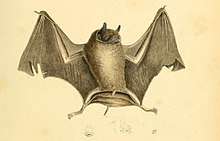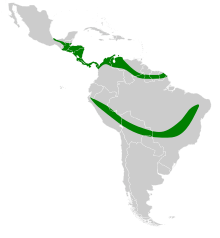Big naked-backed bat
The big naked-backed bat (Pteronotus gymnonotus), is a bat species from South and Central America.
| Big naked-backed bat | |
|---|---|
 | |
| Scientific classification | |
| Kingdom: | Animalia |
| Phylum: | Chordata |
| Class: | Mammalia |
| Order: | Chiroptera |
| Family: | Mormoopidae |
| Genus: | Pteronotus |
| Species: | P. gymnonotus |
| Binomial name | |
| Pteronotus gymnonotus (Wagner, 1843) | |
 | |
| Synonyms | |
| |
Taxonomy
It was described as a new species in 1843 by German zoologist Johann Andreas Wagner. Taxon authority is sometimes given to Johann Natterer, however.[2] According to the International Code of Zoological Nomenclature's Principle of Priority, the first author to publish a species name is considered the authority of that name. Smith (1977) hypothesized that Wagner copied Natterer's species description directly from his diary, and thus gave Natterer the authority. Carter and Dolan (1978) stated that Wagner's description was not comparable to Natterer's, which is why they attribute the name to Wagner.[3] The reference texts Mammals of South America and Mammals of Mexico also list Wagner as the authority.[2][4]
Description
Instead of attaching to the sides of the bat, its wings attach to its back near its spine. This gives individuals the appearance of having a "naked back" due to the lack of fur on its wings. However, its back is furred under the wings. Individuals weigh 12–16 g (0.42–0.56 oz) and have a forearm length of 49–56 mm (1.9–2.2 in). It has a dental formula of 2.1.2.32.1.3.3 for a total of 34 teeth.[4]
Range and habitat
The big naked-backed bat is found in Central and South America.[2] Its range includes the following countries: Belize Bolivia, Brazil, Colombia, Costa Rica, Ecuador, El Salvador, Guatemala, Guyana, Honduras, Mexico, Nicaragua, Panama, Peru, and Venezuela. It has only been documented at elevations below 400 m (1,300 ft) above sea level.[1]
Conservation
As of 2008, it is evaluated as a least-concern species by the IUCN. It meets the criteria for this classification because it has a wide geographic range; its range includes protected areas; its population is presumably large; and it is unlikely to be experiencing rapid population decline.[1]
References
- Solari, S. (2019). "Pteronotus gymnonotus". IUCN Red List of Threatened Species. 2019: e.T18706A22077065. doi:10.2305/IUCN.UK.2019-1.RLTS.T18706A22077065.en.
- Gardner, A. L. (2008). Mammals of South America, Volume 1: Marsupials, Xenarthrans, Shrews, and Bats. 1. University of Chicago Press. p. 381–382. ISBN 978-0226282428.
- Carter, D. C.; Dolan, P. G. (1978). "Catalogue of type specimens of neotropical bats in selected European museums". Special Publications of the Museum: Texas Tech University. 15: 26–27.
- Ortega R., J.; Arita, H. T. (2014). Ceballos, G. (ed.). Mammals of Mexico. JHU Press. pp. 747–748. ISBN 978-1421408439.
